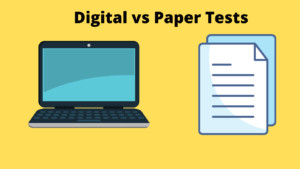PRO:
May 16, 2022
As technology advances, numerous educational departments are making the transition from standardized testing on paper to digital testing instead. When it comes to standardized testing, opening up the process of replacing paper versions with computer-based testing provides benefits towards students and educators by adding new opportunities for students and providing them with new perspectives on learning.
Benefits in making the switch to digital testing are that students will no longer need to wait and can get their test results immediately. Digital tests also have useful, interactive simulations and multimedia that test takers can use. Through these benefits, a great opportunity is provided for students to try something new rather than relying on paper packets
On paper, students don’t get their test results immediately. It has been documented that the majority of students experience having stress and anxiety while waiting for their test results back. Instant results help prevent this and having to wait for results as usual.
“With online exams, except for certain tests like essays, students can know their test results immediately resulting in less anxiety and pressure which affects their learning capability in the long run,” according to the eLearning industry online, a publishing platform that delivers content directed towards eLearning professionals.
Some students also have a harder time engaging and lack of focus when testing on paper. A simple paper and pencil test doesn’t draw any interest towards students and quickly loses their attention, making them feel boredom. The S.A.T (“Scholastic Aptitude Test”) , is a three hour standardized test by College Board, used widely for college admissions across the United States and is a prime example of a test that doesn’t create engagement for students. The S.A.T was first in use from 1926, and has been taken on paper ever since. However, the College Board announced that the SAT is working towards making the test digital instead beginning later in 2024.
Unlike paper tests, computer based tests have interactive simulation tools on questions that students are able to use which includes rulers, calculators, zoom in features, the option to eliminate question answers, and further. Other multimedia such as videos are also included. The use of these advanced tools help students feel more engaged in their testing and draws their focus back by having interesting material provided.
These interactive tool simulations are also very helpful towards students with accommodations and disabilities that find it hard to test on paper. They are able to use the tools the computer testing comes with to give them an easier time and complete the test quicker than it would be on paper without it being as complicated.
While paper testing is still a good choice and the norm for students, change can be just as beneficial and computer based tests should continue to grow throughout the educational communities and provide students with new opportunities.





noah • May 3, 2024 at 4:51 pm
awesome brotato, thanks for helping me on my essay